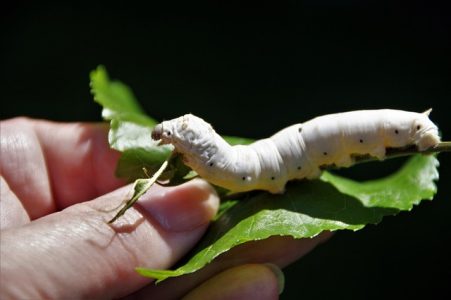
A Silk Worm
Silk, often referred to as the “Queen of Fabrics,” is one of the most luxurious and sought-after materials in the world of textiles. Its fine texture, natural sheen, and exquisite feel have made it a symbol of elegance and opulence for centuries. In this article, we’ll take you on a journey to discover the fascinating process of how silk is made, from the cultivation of silkworms to the creation of this exquisite fabric.
Step 1: Silkworm Rearing
The journey of silk begins with the humble silkworm. These small, voracious creatures are the primary producers of silk. The silk thread, also known as the cocoon, is produced by the silkworm to protect itself during the pupal stage.
Silkworms are typically reared in controlled environments, where they are fed exclusively on mulberry leaves. The quality of the leaves and the care given to the silkworms are crucial factors in determining the quality of the silk they produce.
Step 2: Cocoon Formation
As silkworms grow, they spin their protective cocoon around themselves. Each cocoon is made up of a single, continuous silk thread, which can be up to 900 meters long! This incredible thread is what we eventually weave into fabric.
The silkworm secretes a protein known as fibroin, which hardens into silk fibers when exposed to air. The intricate process of cocoon formation is a marvel of nature.
Step 3: Harvesting the Cocoons
When the cocoons are ready, they are carefully harvested to preserve the integrity of the silk threads. To do this, the cocoons are placed in hot water, which softens the sericin, a natural gum that holds the threads together.

Silk cocoon the commercially bred caterpillar of the domesticated silkworm moth, which spins a silk cocoon that is processed to yield silk fibre.
The softened sericin allows the silk threads to be gently unraveled without breaking, resulting in long, continuous strands of silk.
Step 4: Spinning Silk Yarn
The unraveled silk threads are then spun into silk yarn, creating the foundation for weaving the fabric. This step can be done by hand or with the help of machinery, depending on the scale of production.
The silk yarn can vary in thickness and texture, allowing for a wide range of fabric options, from lightweight and delicate to sturdy and durable.
Step 5: Weaving the Fabric
The spun silk yarn is woven into fabric using traditional weaving techniques or modern industrial looms. The choice of weave, be it plain, satin, or twill, influences the texture and appearance of the final fabric.
Silk fabric can be further enhanced with intricate patterns and designs, including floral motifs, geometric shapes, or simply left plain to showcase the natural beauty of the material.
Step 6: Dyeing and Finishing
Once the silk fabric is woven, it undergoes a dyeing and finishing process. This is where the fabric is treated to enhance its color, texture, and luster. Dyeing can be done in a wide range of colors, adding to the versatility of silk.
Finishing processes like calendering and glazing can give silk its signature smooth and shiny finish.
Step 7: Quality Control
Quality control is a crucial step in the silk production process. Skilled artisans inspect the fabric for any imperfections, ensuring that only the finest silk makes its way to market.
This meticulous attention to detail guarantees that silk retains its reputation for exceptional quality.
Conclusion
The journey from silkworm to silk fabric is a testament to the intricate and time-honored craft of silk production. The result is a luxurious material that has captivated the world for centuries, with its beauty, softness, and natural sheen. From the humble silkworm to the skilled artisans, every step in the silk-making process is a testament to human ingenuity and nature’s wonders.
As you wrap yourself in a silk scarf or don a silk garment, you are not only embracing luxury but also a rich history of craftsmanship and dedication. The allure of silk, with its centuries-old traditions, is an enduring testament to the art of crafting beauty from the threads of nature.
